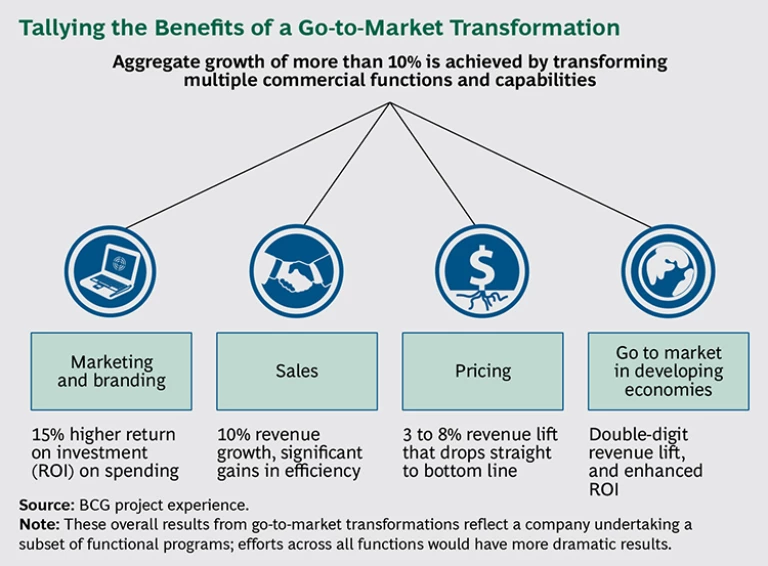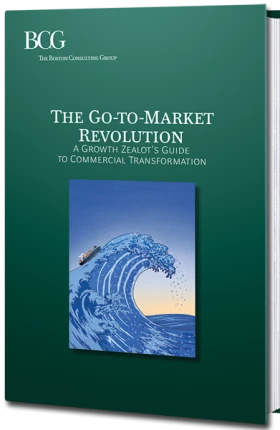In the current environment of uncertainty and financial constraint, too many companies have looked to their go-to-market functions—sales, marketing, pricing, branding, and customer insight—for savings, not growth.
A small set of successful companies are taking a different path. They are transforming their commercial functions and capabilities to create an engine of short-term revenue growth and long-term profit. And they are doing so with little risk—because the creation of these strategic capabilities more than pays for itself via growth in the top and bottom line. In essence, it’s growth for free.
These leading companies are taking advantage of what The Boston Consulting Group calls the “Go-to-Market Revolution.”
The Go-to-Market Revolution is a wave of technological and customer-driven change that is altering the level of sophistication with which companies can deploy their commercial capabilities. This new era hasn’t altered the fundamentals required for go-to-market excellence, but it is creating important new possibilities. It is taking what is now possible—the current state of the art in commercial functions—to the next level.
A Revolution Driven by Three Tides of Change
Three tides of deep-rooted change are driving the revolution. The first is the dramatic shift, in almost every industry, of what BCG calls customer pathways—the ways customers learn and communicate about products and services on the path toward a purchase. What was once a company-centered world with carefully crafted information broadcast to customers through a handful of channels has evolved into a customer-centered and much more transparent universe of Internet connectivity, Web searches, cable channels, peer-review marketing, and mobile devices and apps. Customer trust is a critical source of sustained competitive advantage, and it needs to be managed as a line activity. Brands must be backed by high-quality products and authentic corporate missions. Marketing teams must be capable of managing greater personalization and faster feedback loops.
Second, technology and advanced analytics are providing a powerful new arsenal of tools for sales and pricing teams, marketers, and researchers. The concept of segmenting markets by geography or customer type has been around for decades. What’s different now is that digital and mobile technologies allow access and analysis of enormous quantities of sales and marketing information at a more microscopic level than ever before. Companies can quickly and inexpensively gather data from the field without an army of IT specialists and data experts. Cheap and effective data manipulation is leveling the playing field for smaller companies. It is revolutionizing sales force deployment, customer segmentation, product promotion, and return on marketing investment.
Third and finally, companies now navigate a globalizing world that requires most of them to compete in new markets, often against unfamiliar rivals. Globalization has destabilized brands and prices and empowered new developing-world challengers. It is shortening product cycles and speeding shifts in consumer tastes. At the same time, it has driven rapidly expanding wealth in emerging economies, making them a huge potential source of growth.
The three tides of change are accelerating and have contributed to the disruption and heightened competitive pressures that affect virtually every global industry today. At the same time, they have bred a new and dynamic commercial environment. For business leaders with ambition and foresight, the Go-to-Market Revolution offers a multitude of fresh opportunities to attract and engage customers and to drive growth and profitability. As one business leader put it: “If you are doing things the same way you did them three years ago, you’re almost certainly doing something wrong.”
One consumer goods company, for example, hired 4,000 part-timers to input on their Android phones sales and retail data from hundreds of thousands of retail outlets in Southeast Asia. The company then carved an area it has formerly treated as two large regions into more than 1,500 segments. Deploying the data with mobile sales force tools enabled incremental growth of more than 10 percent.
A Self-Funding Go-to-Market Transformation
A go-to-market transformation aggressively retools a company’s commercial functions—sales, marketing, pricing, branding, and customer insight—to exploit the new possibilities while navigating a fast-moving landscape. It adapts processes to changing customer pathways and needs, prepares the company to face new global markets and competitors, and arms its go-to-market teams with the latest and most effective technology.
There is a rich prize for leading-edge adopters that ride the wave. Through comprehensive go-to-market transformation, companies we know are able to capture 10 percentage points or more of incremental growth. Some expand margins by 5 points or more. Every commercial area has the potential to contribute significant growth and margin. (See the exhibit “Tallying the Benefits of a Go-to-Market Transformation.”)
Go-to-market transformation is a particularly potent lever for growth because it exploits tactical, short-term victories to fund broader commercial transformation over the medium term. For example, one company started with a sales force effectiveness program that drove more than $20 million in near-term value—an early success that energized the organization and created a financial foundation for a broader go-to-market transformation. From such beginnings, the ambitious company funded a larger set of programs, which in turn produced a step change in both commercial capabilities and value delivery.
This transformational approach contrasts with conventional attempts to adapt through continuous improvement—a recipe for simply keeping pace with market growth. Our view is that, for most companies, the current scope of change in the commercial landscape is too disruptive for incremental change to be effective. Maximizing value requires an aggressive and dedicated response.
Commercial transformation has a confirmed record of success in generating growth for a broad range of companies worldwide. They include a global manufacturer of mobile handsets, a European gas and energy utility, a U.S.-based retail bank, retailers, postal operators, and media companies.
The resulting revenue benefits are powerful in today’s era of difficult growth, when even modest revenue growth can create substantial shareholder value. Mature companies that increased their top line by just 2 percentage points or more delivered shareholder returns 40 percent higher than the market average.
Growth Zealot or Go-to-Market Laggard?
Your company can ignore the potential benefits of the Go-to-Market Revolution, but it can’t avoid the perils of failing to take part. The gap between capability leaders and laggards is growing.
If you are prepared to be a zealot for growth, here is a sample sequence of actions and best practices to consider.
- Start with vision and ambition. Does your company currently have the vision to transform your go-to-market capabilities? Do you have the ambition to increase your top line 10 or 20 percent beyond current projections in the next few years? A necessary first step is helping your leadership team understand the opportunities inherent in the Go-to-Market Revolution.
- Undertake a quick initial diagnostic step. Map how your customers’ purchase pathways have changed. Assess your commercial capabilities: marketing, pricing, sales, branding, and insight. Determine where you stand compared with best-in-class competitors and identify which commercial functions offer the greatest near-term opportunity.
- Tailor a series of programs to build capabilities and improve performance simultaneously. For example, start with a high-impact pricing initiative. Some leading companies we know have begun with a pricing program that added tens of millions of dollars to the bottom line. Simultaneously, the programs have funded development of new pricing tools and capabilities, such as sophisticated discounting, mobile technologies, and advanced analytics.
- With initial success in place, expand your efforts rapidly. For example, launch a program that boosts marketing effectiveness—such as a brand advocacy campaign. Then launch another—such as a sales-activation initiative—to equip your sales force with a technical arsenal of twenty-first-century tools.
Make no mistake, you may need several waves of activity to meet your objectives in each commercial discipline. Indeed, achieving your overall profit and strategy goals will take years, not months. If it’s done right, however, the journey will more than pay for itself. What is more, every growth gain and each advance in capabilities can create a reinforcing cycle of improvement for the entire enterprise.
Crucial to success in this endeavor is capable executive leadership. Company leaders must be committed to guiding and supporting the transformation across all three tides of change that drive the Go-to-Market Revolution: the new and uncharted pathways your customers are taking to discover and purchase your products; the evolution of data, advanced technologies, and analytics that can rearm your commercial teams; and the rise of emerging markets, which brings new growth and also new global competitors.
These are real challenges. For the bold, though, they present powerful paths to competitive advantage.
The growth zealot must be a leader—able to inspire executives, managers, and employees; capable of transforming the whole by reinventing its parts; committed to forging a new commercial future for the enterprise.







